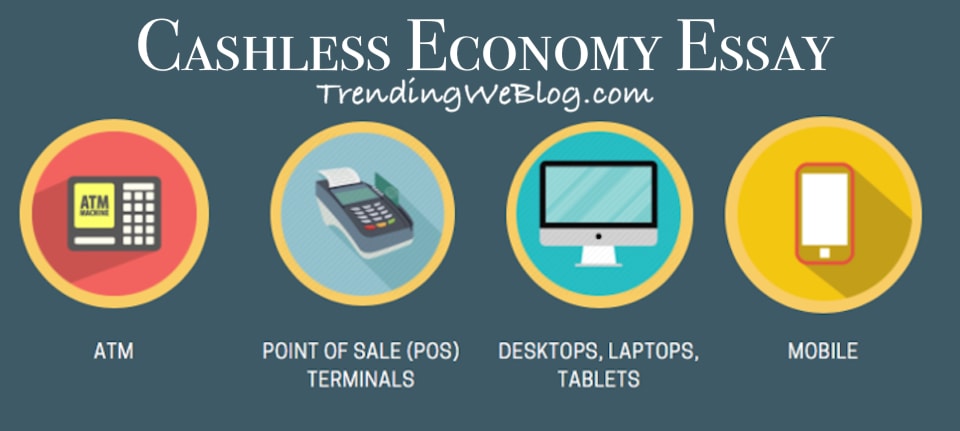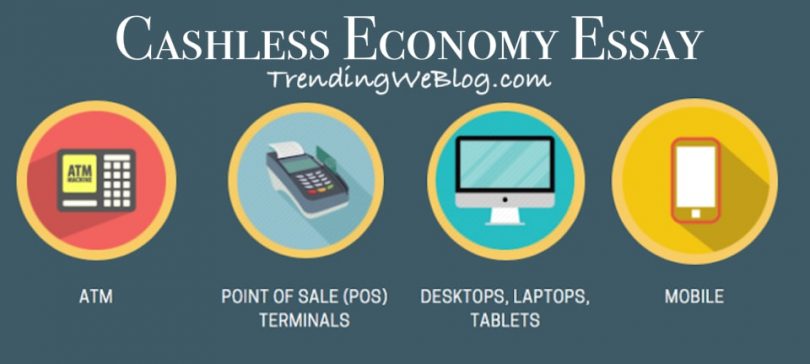Cashless Economy essay for Class 1, 2, 3, 4, 5, 6, 7, 8, 9, 10, 11 and 12. Find paragraph, long and short essay on Cashless Economy for Students.

Cashless Economy Essay In English
Cashless Economy Essay 300 Words
Cashless economy means the economy within which cash flow is nonexistent or very less and all transactions are from electronic clearing and payment system such as IMPS, NEFT, RTGS, UPI, Mobile banking etc. The country embarked upon this transition to a less cash economy when the government took the revolutionary step of demonetization. It is necessary to reduce dependency on cash and to bring hoards of stashed black money lying unused into the banking system. The government is digitizing all departments to promote electronic departments.
India has very high Cash to GDP ratio as compared to rest of the world, which should be reduced. Most of the people use cash for day to day activity, low internet penetration and awareness among people. Reduction in black money, corruption, tax evasion and anti-social and anti-national activities.
It will lead to greater transparency, ease and convenience in monetary transactions and increased liquidity in the banking system. It saves the substantial costs of printing and circulating currency notes. Online banking has gained prominence due to consistent efforts of government (BHIM App etc) and increased participation of people. But it faces various barriers such as the slow speed of the Internet, cybersecurity, digital infrastructure, lack of digital literacy and awareness among people. Integration of the unorganized sector which constitutes about 80% of our economy. There is only 18% internet penetration; inclusive internet and connectivity for all index rank us 47th in the world.
Technological literacy and better digital infrastructure will make India an economic powerhouse. Comprehensive law and strict punishment for cyber crimes and illegal transactions. The e-payments services and digital transactions are gaining unprecedented momentum. Initiatives like Digital India Campaign and participation of informed citizens will transform the country into a cashless society in near future.
Cashless Economy Essay 550 Words
An economy where all of the finical transaction is done using digital means or plastic money (cards). Physical currency circulation is minimal. It has got a boot after the demonetisation announcement by the government. Because of less cash availability with people, they are encouraged (or maybe forced) to use digital means. About 98% transaction in India is done with cash and 2 percent are cashless. India has one of the highest cash to gross domestic product ratios in the world.
It reduces tax evasion/avoidance and so tax to GDP ration will improve as the government will have access to enhanced financial trial. Banks will have more money with them and so loans and investments will increase and so will the number of startups resulting job growth. It will curb the menace of black money to some extent. It will reduce illegal activities like smuggling, trafficking, terror funding etc.
As a result of this, dependency on Banks and ATM’s will be reduced and so it would be a step in the direction of universal banking services. It will result in improved transparency and so greater efficiency in welfare programmes. Plastic money and cashless transactions are relatively hygienic. Cost of currency printing, cash handling etc will go down. The election may become cleaner and more transparent.
The cashless economy needs extreme dependency on the internet. Internet penetration is not up to that level in most parts of the country and so is the condition of digital literacy. Merely 26% of India has internet access, and there are only 200 million users of digital payment services. The World Bank’s Global Findex shows that Indians are significantly less familiar with digital banking – the use of credit or debit cards, making transactions using mobile phones and using the internet to pay bills than their peers in middle-income nations.
Cyber security infrastructure is not up to the mark and so the number of online frauds may increase. The general mindset of people finds it easy to transact with cash. An unorganized sector which is around 90 percent uses cash for wage labours. There is no secrecy. We have a complex socio-economic structure of society. In many poor households where husbands have a habit of consuming liquor or squandering money, wives/mothers keep some money secretly for any emergency needs.
The government has taken steps like licensing of payment banks, encouragement to mobile wallets and similar services, launching to UPI (Unified Payment interface). The government has recently announced several benefits and discounts on online transactions and reduced surcharge, service charge on cards and digital payments.
The UPI is a revolutionary new payment mechanism that provides for a safe and secure manner of making a payment without sharing the bank account number of IFSC codes. This is possible through the generation of a Virtual Payment Address (VPA) that can be obtained by anyone with an account in a participating bank.
Cyber infrastructure should be strengthened and made secure to avoid frauds and to build people’s faith in this transitioning. Digital literacy programmes should be encouraged. This can be done by conducting workshops in rural and far-flung areas and by utilising Digital India Programme and Skill India Programme. Some sort of cyber insurance plan should be framed against online frauds and technical glitches so as to provide instant redressal to customer’s grievances.







